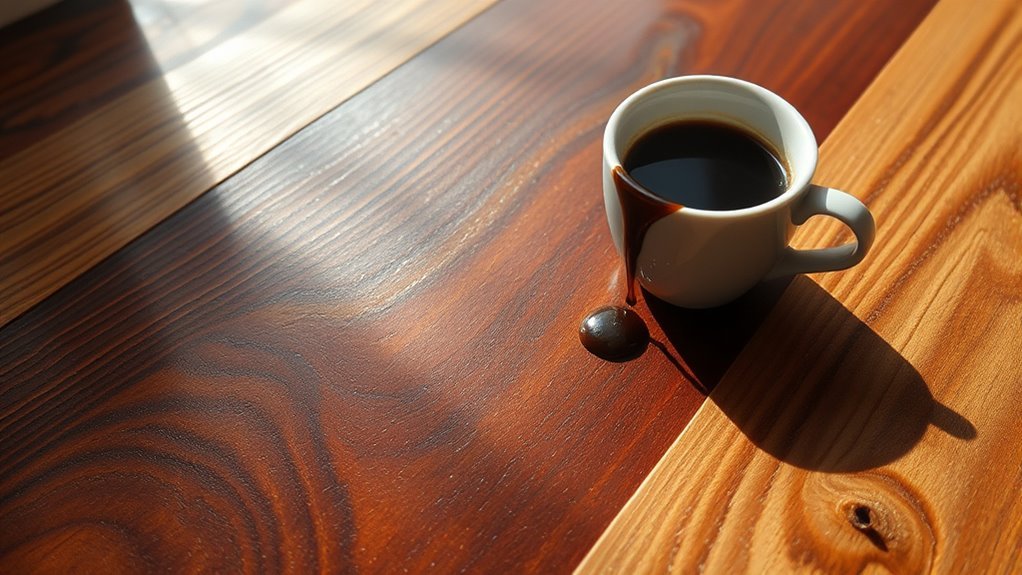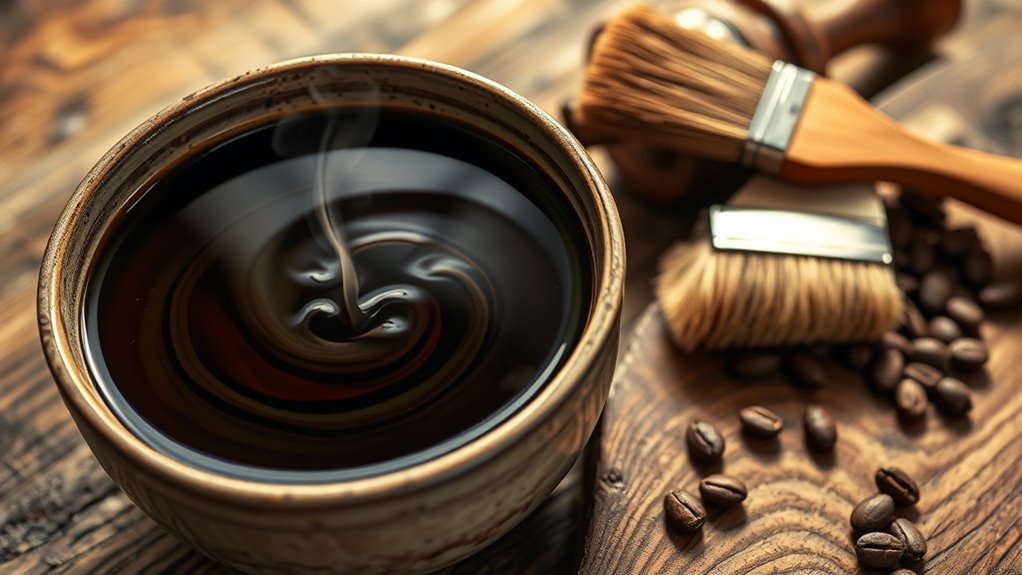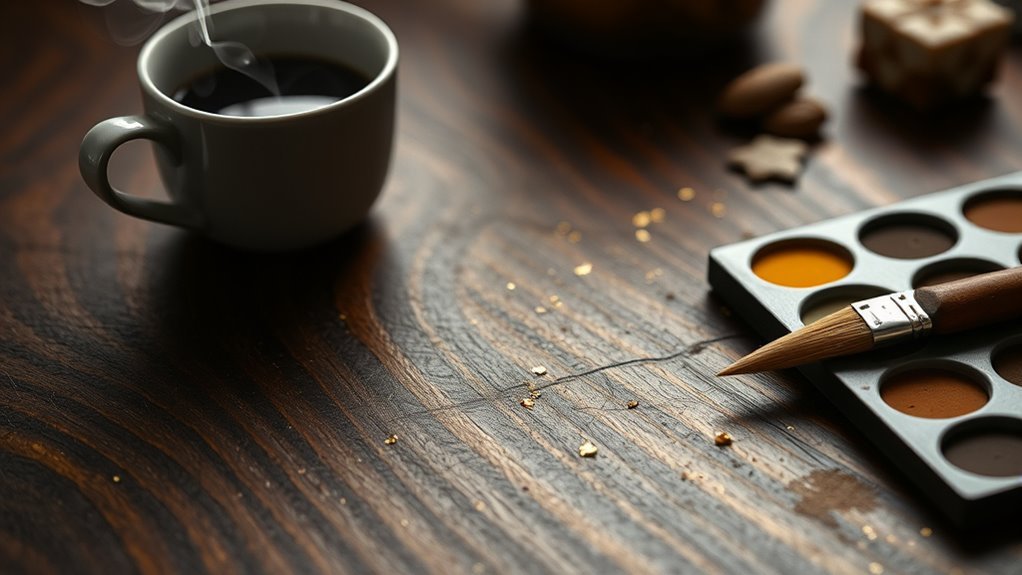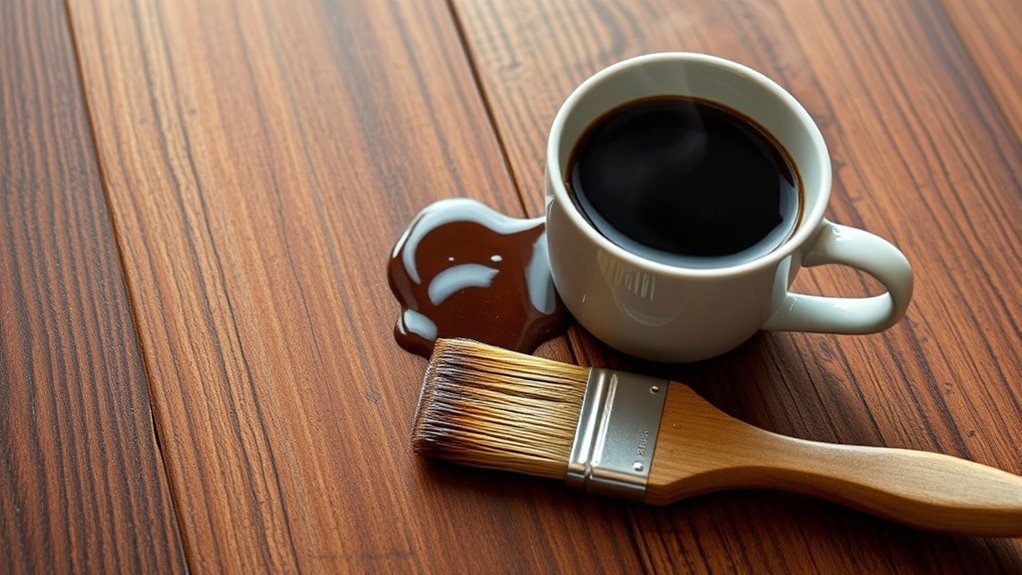Can You Stain Wood With Coffee
Yes, you can stain wood with coffee! Its natural pigments and tannins create a beautiful, warm finish that enhances wood grain. Start by preparing your wood properly—clean and sand the surface for best results. Choose your coffee based on the desired stain intensity; darker brews yield richer tones. Apply the stain evenly, following the wood grain, and allow it to dry completely. For deeper colors and longevity, sealing the stained surface is essential. Discover more techniques for a perfect finish.
Understanding the Properties of Coffee as a Stain

Although you might not think of coffee as a wood stain, its natural properties can actually make it an effective option for coloring and enhancing the grain of various wood types. The coffee color properties stem from its rich pigments, primarily tannins, which interact with the wood fibers, creating a deep, warm hue. When used as a stain, coffee provides a unique finish that emphasizes the wood’s natural textures. Utilizing natural dyeing methods, you can achieve different shades by varying the brew strength or the application technique. For instance, a stronger brew yields a darker tone, while a diluted version offers a lighter finish. This versatility allows you to customize your projects, embracing a sustainable approach to wood finishing.
Preparing Your Wood for Staining
Before you start staining with coffee, it’s essential to prepare your wood properly. First, choose the right type of wood that will absorb the coffee stain effectively. Then, make certain the surface is clean and smooth by thoroughly cleaning and sanding it, which will help achieve an even finish.
Choosing the Right Wood
Selecting the right type of wood is essential for achieving a successful coffee stain. Different wood types react uniquely to staining, so consider the grain patterns and density. Hardwoods, like oak and maple, absorb coffee stains well, enhancing their natural beauty and depth. Softer woods, such as pine, may not hold the color as effectively, leading to uneven results. Pay attention to the grain patterns; open grains will allow the coffee to penetrate more deeply, creating richer tones. Conversely, tightly grained woods may require more staining for a similar effect. Experimenting with samples can help you determine which wood type and grain pattern suit your desired outcome, ensuring your project’s success and your creative freedom.
Cleaning the Surface
Once you’ve chosen the right type of wood for your project, the next step is cleaning the surface to guarantee ideal staining results. Effective surface preparation is essential, as any dirt, dust, or grease can hinder the absorption of your coffee stain. Start with a damp cloth to wipe away loose debris, then consider using a mild soap solution for tougher grime, followed by a thorough rinse. You might also employ specialized wood cleaners, ensuring they’re compatible with your wood type. Always allow the surface to dry completely before proceeding to stain. Remember, proper cleaning methods not only enhance the finish but also promote longevity, ensuring your project stands out beautifully.
Sanding for Smoothness
To achieve a flawless finish when staining wood with coffee, sanding is an essential step that shouldn’t be overlooked. Start with coarse sandpaper, like 80-grit, to remove any imperfections or old finishes. Follow up with finer grits, such as 120 and 220, to gradually refine the surface. Utilize sanding techniques like circular motions or the grain direction, ensuring you maintain an even pressure. This helps prevent scratches and promotes smooth finishes. After sanding, always wipe the surface with a damp cloth to remove dust particles, allowing for better absorption of your coffee stain. Remember, the smoother the wood surface, the more vibrant and even your stain will appear. Enjoy the freedom of custom finishes that highlight your creativity!
Choosing the Right Coffee for Staining
When it comes to staining wood with coffee, the choice of coffee can greatly impact the final color and finish. Different coffee varieties yield varying stain intensities, affecting how your wood appears. Here’s a quick guide to help you select the right coffee:
| Coffee Variety | Stain Intensity | Notes |
|---|---|---|
| Light Roast | Light | Subtle tones; good for a natural look. |
| Medium Roast | Medium | Balanced color; versatile for many woods. |
| Dark Roast | Dark | Rich, deep hues; ideal for dramatic effects. |
| Espresso | Very Dark | Intense color; perfect for bold finishes. |
| Instant Coffee | Variable | Convenient but may lack depth. |
Choosing wisely guarantees your wood staining project achieves the desired aesthetic while allowing your creativity to shine.
How to Brew Coffee for Wood Staining

To effectively brew coffee for wood staining, start by selecting high-quality beans, as the type will influence the final color and finish. Next, you’ll need to apply specific brewing techniques, such as adjusting the grind size and water temperature, to extract the best pigments from the coffee. This careful preparation guarantees a rich, deep stain that enhances the wood’s natural beauty.
Choosing the Right Beans
Although you might think any coffee will do, choosing the right beans is essential for achieving the desired stain effect on wood. You’ll want to focus on Arabica vs. Robusta beans; Arabica offers a smoother, more nuanced flavor profile, while Robusta provides a stronger, bolder taste. For wood staining, Arabica’s subtle notes can create a richer, more refined finish, allowing the wood grain to shine through beautifully. Conversely, Robusta, with its higher caffeine content and bitterness, might yield a darker stain but can overpower the wood’s natural characteristics. Experimenting with different blends can also enhance your results, so consider your project’s aesthetic goals. Ultimately, the right beans will elevate your staining experience and create stunning results.
Brewing Techniques Explained
Once you’ve selected the right coffee beans, the next step is brewing the perfect coffee for wood staining. Different brewing methods extract unique flavors and intensities, impacting your stain’s color. Here’s a quick guide to help you choose:
| Brewing Method | Coffee Varieties | Strength Level |
|---|---|---|
| French Press | Medium Roast | Strong |
| Pour Over | Dark Roast | Bold |
| Cold Brew | Light Roast | Smooth |
| Espresso | Espresso Beans | Intense |
Experiment with these techniques to find the ideal brew for your project. Remember, the right coffee variety and brewing method can elevate your wood stain, giving it depth and character. Enjoy the freedom of creativity!
Applying Coffee Stain to Wood
When you’re ready to apply coffee stain to wood, it’s vital to prepare the surface properly to achieve an even and rich finish. Start by sanding the wood to remove any imperfections and guarantee a smooth surface. Make sure to clean off any dust or debris—this helps the stain adhere better. Next, decide on your coffee concentration; a stronger brew will yield a darker stain, while a lighter brew will create a more subtle effect. Using a brush or cloth, apply the coffee stain evenly, working in the direction of the wood grain. Allow it to sit for a few minutes before wiping off any excess. Let the stain dry completely before considering any additional coats for a deeper color.
Enhancing the Stain With Additional Techniques

After you’ve applied your coffee stain and allowed it to dry, you might want to contemplate enhancing the finish with additional techniques. One effective approach is using color layering techniques to create depth. You can apply a second stain—perhaps a tea or walnut-based stain—to achieve rich variances in tone. This method allows you to experiment with how different hues interact, giving your wood a unique character.
Incorporating natural additives like vinegar or iron filings can also enrich the stain, resulting in darker shades and increased complexity. When using these additives, test them on scrap wood first to guarantee you achieve the desired effect. By employing these techniques, you can elevate your coffee-stained wood to a whole new level.
Sealing and Protecting Your Stained Wood
Although staining wood with coffee adds a beautiful, unique finish, it’s essential to seal and protect that surface to secure longevity and durability. You can choose from various sealing finishes like polyurethane, which offers excellent durability and water resistance. For a more natural look, consider using oil-based finishes, as they penetrate the wood and enhance the stain’s depth.
Protective coatings, such as varnish or lacquer, can also provide a robust barrier against scratches and moisture. Before applying any finish, verify the stained wood is clean and completely dry. Apply multiple thin coats for the best protection, allowing proper drying time between each layer. This way, you’ll maintain that beautiful coffee-stained appearance while safeguarding your project for years to come.
Tips for Achieving the Best Results

To achieve the best results when staining wood with coffee, it’s important to prepare your surface properly. Begin by following these tips to guarantee a rich, lasting finish:
For optimal results in coffee wood staining, ensure your surface is well-prepared for a rich and lasting finish.
- Choose the Right Coffee Concentration: Experiment with different strengths to find the perfect shade for your wood type. A higher concentration generally yields a darker stain.
- Sand the Surface Smoothly: This helps the coffee penetrate better and enhances adhesion, improving stain longevity.
- Apply Even Coats: Use a brush or cloth to apply the coffee evenly. Multiple thin layers can create a deeper color.
- Allow Proper Drying Time: Let each coat dry thoroughly before applying the next, promoting a more durable finish.
Frequently Asked Questions
Can I Mix Coffee With Other Natural Stains?
You can definitely mix coffee with other natural stains to create unique shades. By exploring natural dyeing techniques, you’ll find that ingredients like tea or plant-based dyes can enhance your coffee stain. This approach offers eco-friendly alternatives to synthetic stains, promoting sustainability in your projects. Experiment with different ratios and combinations to achieve the desired hue, while keeping in mind that the final color may vary depending on the wood type and application method.
How Long Does Coffee Stain Last on Wood?
When you’re considering coffee stain longevity on wood, it generally lasts several months to a few years, depending on conditions like exposure to sunlight and moisture. The coffee stain effectiveness can diminish over time, especially if the wood isn’t sealed properly. To prolong its life, you might want to apply a protective finish over the stain. Keeping your stained wood away from heavy wear can also help maintain that rich, warm hue longer.
Will Coffee Stain Discolor Over Time?
Yes, coffee stains can discolor over time. While they initially provide a rich hue, you might notice color fading due to exposure to sunlight, moisture, and wear. The stain permanence of coffee isn’t as robust as synthetic stains, which means it could lighten or change over time. To maintain its appearance, consider applying a protective finish. This’ll help preserve the vibrant color and extend the life of your coffee-stained wood project.
Can I Remove Coffee Stains From Wood?
You can effectively remove coffee stains from wood using a few methods. Start with a mixture of vinegar and olive oil applied gently to the stained area as part of your wood treatment routine. Alternatively, a paste of baking soda and water can lift the stain without damaging the finish. Always test on a small area first. For stubborn stains, consider professional stain removal options to preserve your wood’s integrity.
Is Coffee Staining Safe for Food-Contact Surfaces?
Think of your kitchen as a canvas, where every choice matters. When it comes to coffee staining wood for food-contact surfaces, you should tread carefully. Coffee, while natural, can harbor bacteria, potentially compromising food safety. If you treat wood with coffee, make certain it’s sealed properly with a food-safe finish to protect against any contaminants. This way, you can enjoy the aesthetics without sacrificing health, keeping your culinary space both beautiful and safe.






